Pg 9 GENESIS GV80 2021 Owner's Guide
[x] Cancel search | Manufacturer: GENESIS, Model Year: 2021, Model line: GV80, Model: GENESIS GV80 2021Pages: 632, PDF Size: 9.37 MB
Page 21 of 632
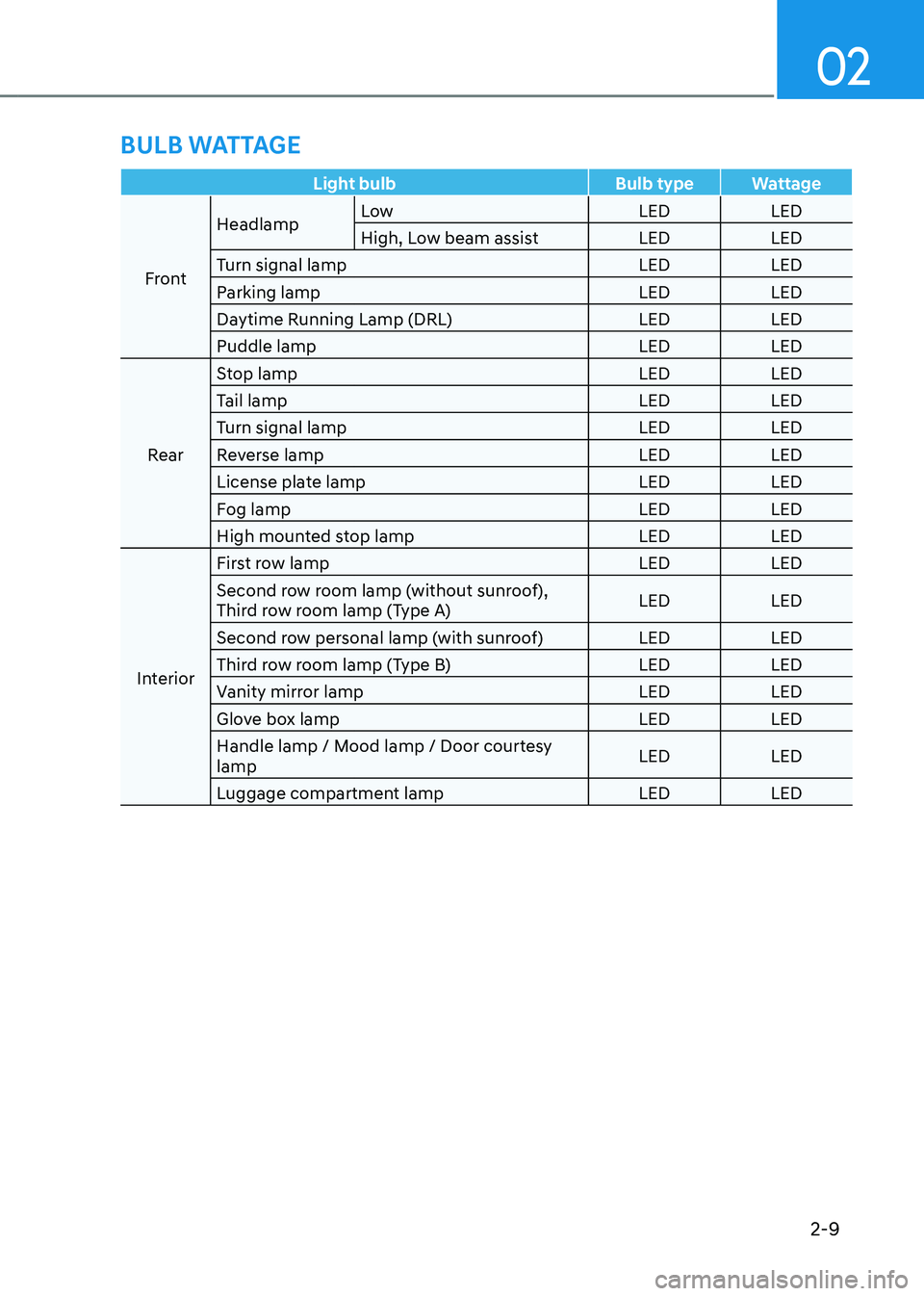
02
2-9
Light bulbBulb typeWattage
Front Headlamp
Low
LEDLED
High, Low beam assist LEDLED
Turn signal lamp LEDLED
Parking lamp LEDLED
Daytime Running Lamp (DRL) LEDLED
Puddle lamp LEDLED
Rear Stop lamp
LEDLED
Tail lamp LEDLED
Turn signal lamp LEDLED
Reverse lamp LEDLED
License plate lamp LEDLED
Fog lamp LEDLED
High mounted stop lamp LEDLED
Interior First row lamp
LEDLED
Second row room lamp (without sunroof),
Third row room lamp (Type A) LED
LED
Second row personal lamp (with sunroof) LEDLED
Third row room lamp (Type B) LEDLED
Vanity mirror lamp LEDLED
Glove box lamp LEDLED
Handle lamp / Mood lamp / Door courtesy
lamp LED
LED
Luggage compartment lamp LEDLED
BULB WATTAGE
Page 22 of 632
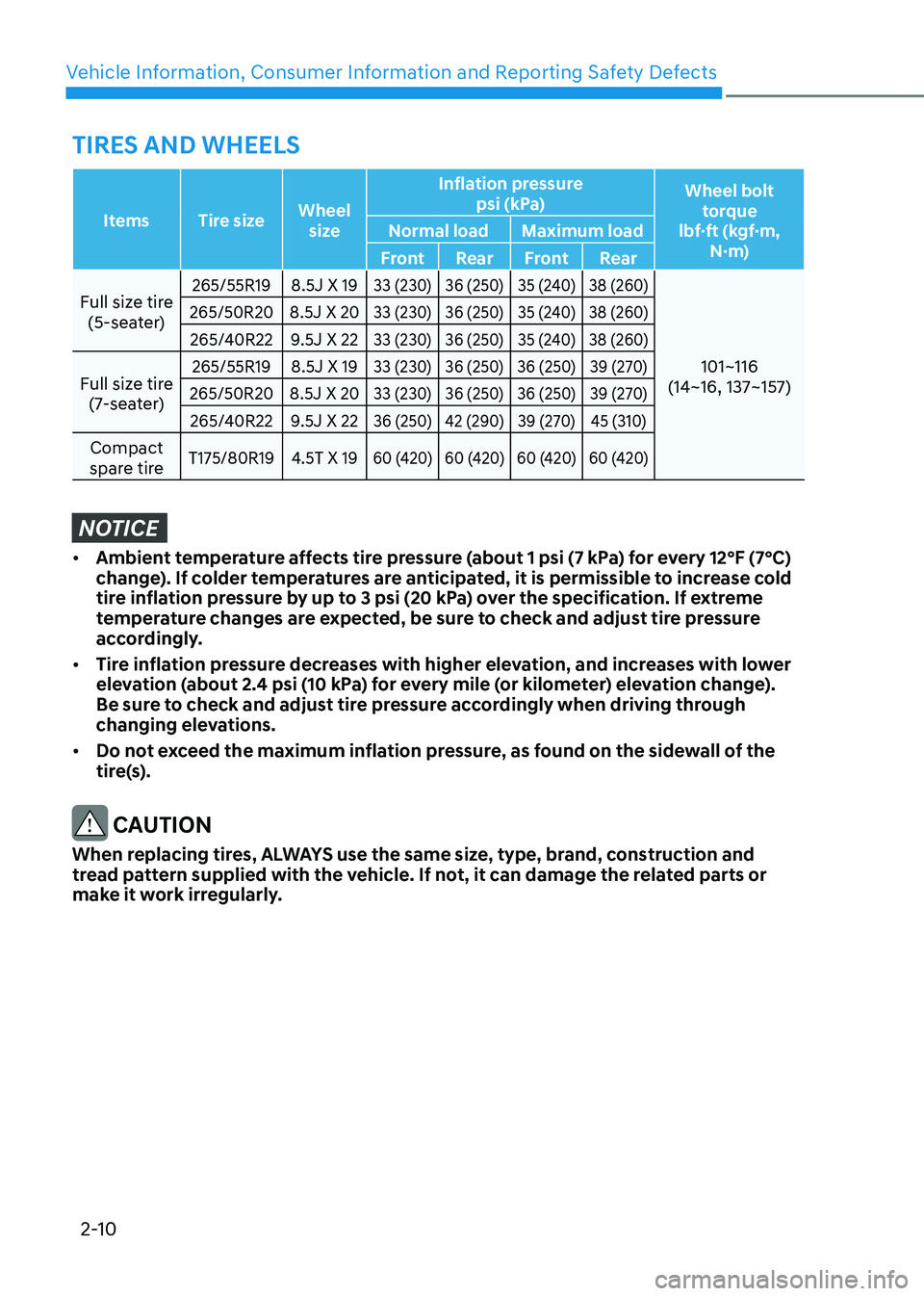
Vehicle Information, Consumer Information and Reporting Safety Defects
2-10
ItemsTire size Wheel
size Inflation pressure
psi (kPa) Wheel bolt
torque
lbf·ft (kgf·m, N·m)
Normal load
Maximum load
Front RearFront Rear
Full size tire (5-seater)
265/55R19 8.5J X 1933 (230)36 (250) 35 (240)38 (260)
101~116
(14~16, 137~157)
265/50R20 8.5J X 2033 (230)36 (250) 35 (240)38 (260)
265/40R22 9.5J X 2233 (230)36 (250) 35 (240)38 (260)
Full size tire
(7-seater)265/55R19 8.5J X 1933 (230)36 (250) 36 (250) 39 (270)
265/50R20 8.5J X 2033 (230)36 (250) 36 (250) 39 (270)
265/40R22 9.5J X 2236 (250)42 (290) 39 (270) 45 (310)
Compact
spare tireT175/80R19 4.5T X 1960 (420)60 (420)60 (420)60 (420)
NOTICE
• Ambient temperature affects tire pressure (about 1 psi (7 kPa) for every 12°F (7°C)
change). If colder temperatures are anticipated, it is permissible to increase cold
tire inflation pressure by up to 3 psi (20 kPa) over the specification. If extreme
temperature changes are expected, be sure to check and adjust tire pressure
accordingly.
• Tire inflation pressure decreases with higher elevation, and increases with lower
elevation (about 2.4 psi (10 kPa) for every mile (or kilometer) elevation change).
Be sure to check and adjust tire pressure accordingly when driving through
changing elevations.
• Do not exceed the maximum inflation pressure, as found on the sidewall of the
tire(s).
CAUTION
When replacing tires, ALWAYS use the same size, type, brand, construction and
tread pattern supplied with the vehicle. If not, it can damage the related parts or
make it work irregularly.
TIRES AND WHEELS
Page 23 of 632

02
2-11
ItemsWeight of volume Classification
Refrigerant 5-seater
21~23 oz. (600~650 g)
R-1234yf
7-seater 29.9~31.7 oz. (850~900 g)
Compressor
lubricant 5-seater
3.1~3.8 oz. (90~110 g)
PAG
7-seater 6.3~7.0 oz. (180~200 g)
Contact an authorized retailer of Genesis Branded products dealer for more details.
VEHICLE WEIGHT AND LUGGAGE VOLUME
Gross vehicle weight
Items 5-seater 7-seater
2.5L T-GDI 2WD
5776 lbs. (2620 kg) 6162 lbs. (2795 kg)
AWD 5930 lbs. (2690 kg) 6294 lbs. (2855 kg)
3.5L T-GDI AWD6107 lbs. (2770 kg) 6526 lbs. (2960 kg)
Luggage volume
Items 5-seater 7-seater
SAE Min.
34.9 cu ft. (990 ℓ) 34.9 cu ft. (990 ℓ)
Max. 84.0 cu ft. (2380 ℓ) 84.0 cu ft. (2380 ℓ)
Min : Behind rear seat to upper edge of the seat back.
Max : Behind front seat to roof.
AIR CONDITIONING SYSTEM
Page 24 of 632
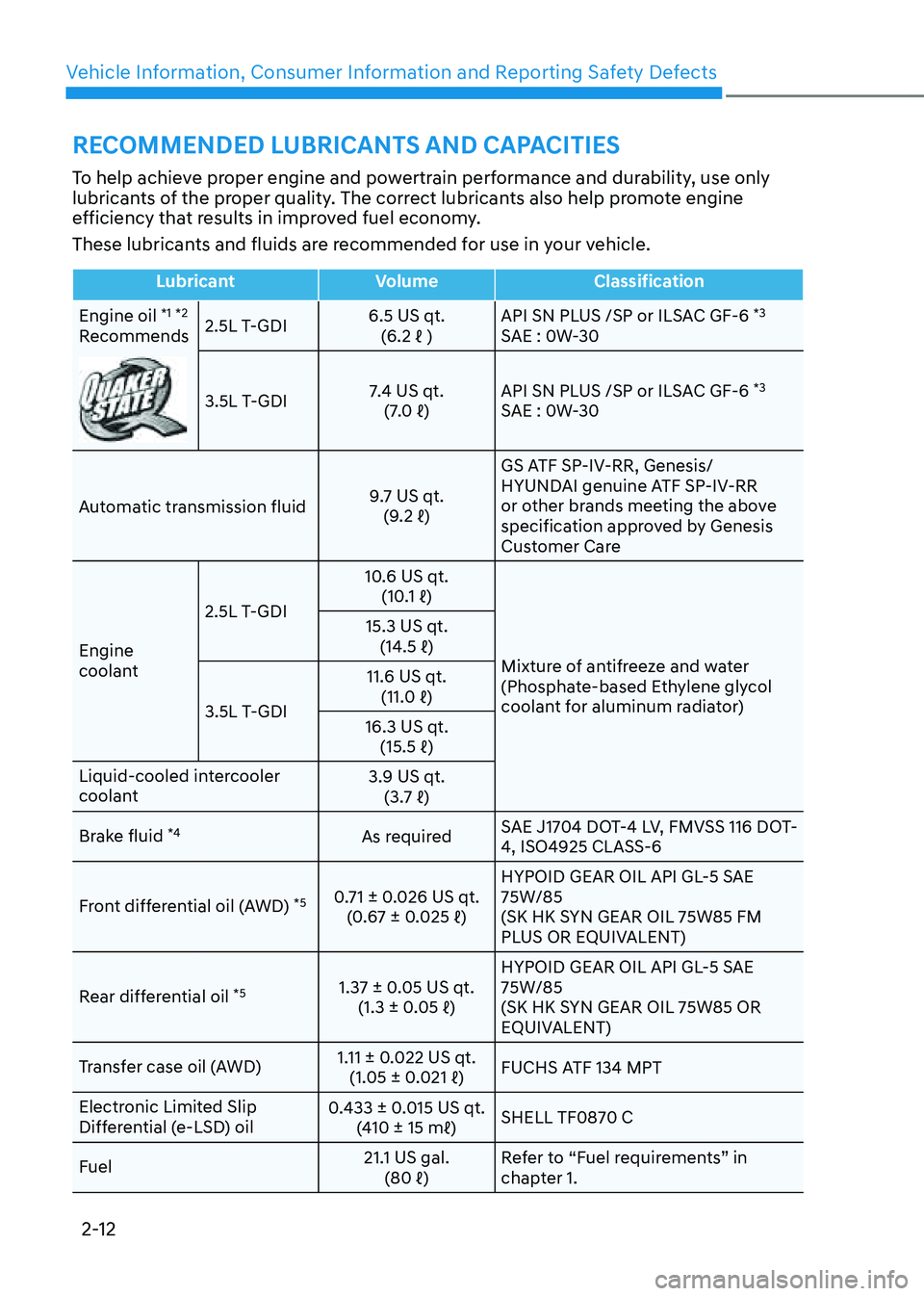
Vehicle Information, Consumer Information and Reporting Safety Defects
2-12
To help achieve proper engine and powertrain performance and durability, use only
lubricants of the proper quality. The correct lubricants also help promote engine
efficiency that results in improved fuel economy.
These lubricants and fluids are recommended for use in your vehicle.
LubricantVolumeClassification
Engine oil
*1 *2
Recommends 2.5L T-GDI 6.5 US qt.
(6.2 ℓ ) API SN PLUS /SP or ILSAC GF-6 *3
SAE : 0W-30
3.5L T-GDI7.4 US qt.
(7.0 ℓ) API SN PLUS /SP or ILSAC GF-6 *3
SAE : 0W-30
Automatic transmission fluid 9.7 US qt.
(9.2 ℓ) GS ATF SP-IV-RR, Genesis/
HYUNDAI genuine ATF SP-IV-RR
or other brands meeting the above
specification approved by Genesis
Customer Care
Engine
coolant 2.5L T-GDI
10.6 US qt.
(10.1 ℓ)
Mixture of antifreeze and water
(Phosphate-based Ethylene glycol
coolant for aluminum radiator)
15.3 US qt.
(14.5 ℓ)
3.5L T-GDI 11.6 US qt.
(11.0 ℓ)
16.3 US qt. (15.5 ℓ)
Liquid-cooled intercooler
coolant 3.9 US qt.
(3.7 ℓ)
Brake fluid
*4As required SAE J1704 DOT-4 LV, FMVSS 116 DOT-
4, ISO4925 CLASS-6
Front differential oil (AWD)
*50.71 ± 0.026 US qt. (0.67 ± 0.025 ℓ) HYPOID GEAR OIL API GL-5 SAE
75W/85
(SK HK SYN GEAR OIL 75W85 FM
PLUS OR EQUIVALENT)
Rear differential oil
*51.37 ± 0.05 US qt. (1.3 ± 0.05 ℓ) HYPOID GEAR OIL API GL-5 SAE
75W/85
(SK HK SYN GEAR OIL 75W85 OR
EQUIVALENT)
Transfer case oil (AWD) 1.11 ± 0.022 US qt.
(1.05 ± 0.021 ℓ) FUCHS ATF 134 MPT
Electronic Limited Slip
Differential (e-LSD) oil 0.433 ± 0.015 US qt.
(410 ± 15 mℓ) SHELL TF0870 C
Fuel 21.1 US gal.
(80 ℓ) Refer to “Fuel requirements” in
chapter 1.
RECOMMENDED LUBRICANTS AND CAPACITIES
Page 25 of 632
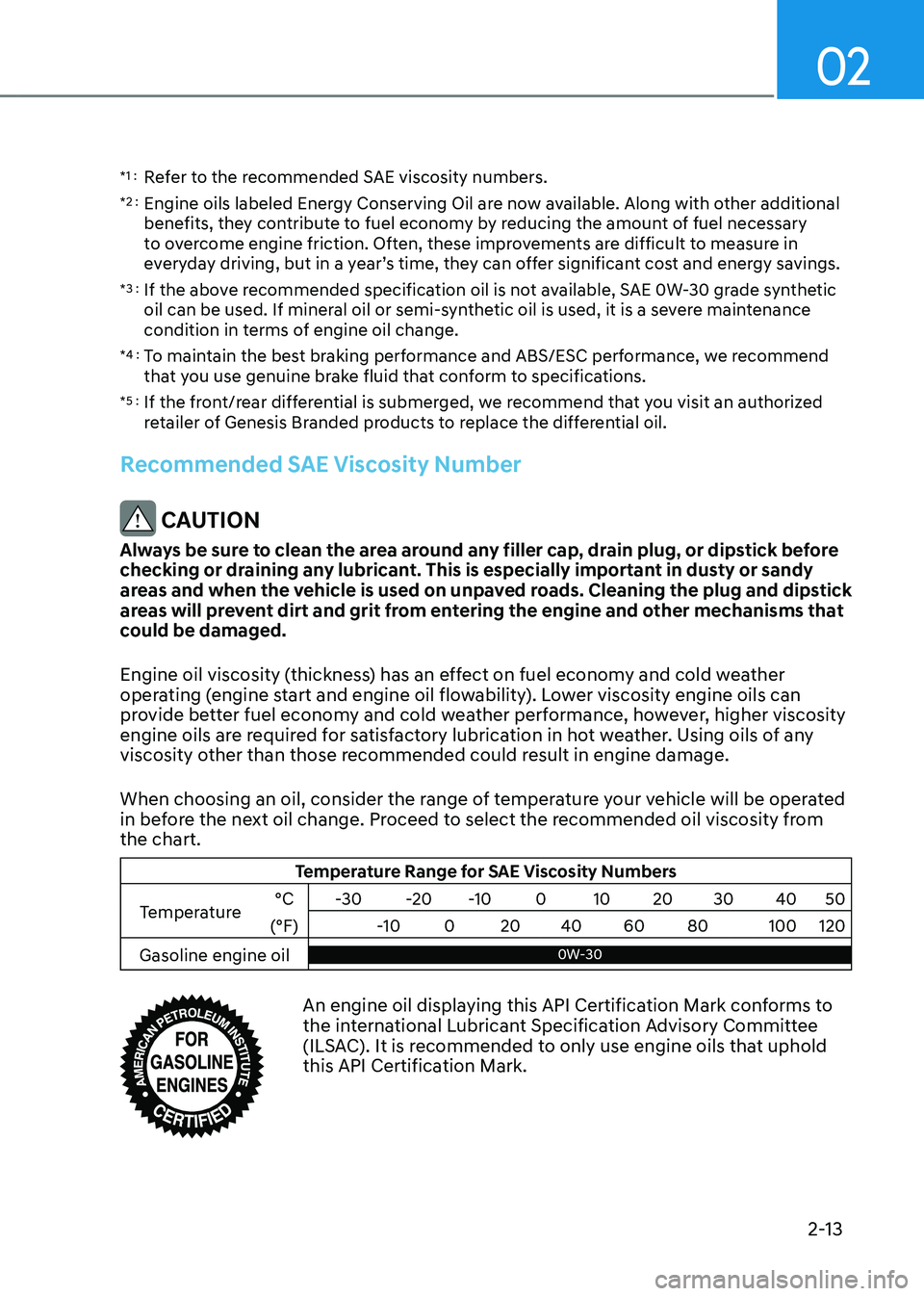
02
2-13
*1 : Refer to the recommended SAE viscosity numbers.
*2 : Engine oils labeled Energy Conserving Oil are now available. Along with other additional
benefits, they contribute to fuel economy by reducing the amount of fuel necessary
to overcome engine friction. Often, these improvements are difficult to measure in
everyday driving, but in a year’s time, they can offer significant cost and energy savings.
*3 : If the above recommended specification oil is not available, SAE 0W-30 grade synthetic
oil can be used. If mineral oil or semi-synthetic oil is used, it is a severe maintenance
condition in terms of engine oil change.
*4 : To maintain the best braking performance and ABS/ESC performance, we recommend
that you use genuine brake fluid that conform to specifications.
*5 : If the front/rear differential is submerged, we recommend that you visit an authorized
retailer of Genesis Branded products to replace the differential oil.
Recommended SAE Viscosity Number
CAUTION
Always be sure to clean the area around any filler cap, drain plug, or dipstick before
checking or draining any lubricant. This is especially important in dusty or sandy
areas and when the vehicle is used on unpaved roads. Cleaning the plug and dipstick
areas will prevent dirt and grit from entering the engine and other mechanisms that
could be damaged.
Engine oil viscosity (thickness) has an effect on fuel economy and cold weather
operating (engine start and engine oil flowability). Lower viscosity engine oils can
provide better fuel economy and cold weather performance, however, higher viscosity
engine oils are required for satisfactory lubrication in hot weather. Using oils of any
viscosity other than those recommended could result in engine damage.
When choosing an oil, consider the range of temperature your vehicle will be operated
in before the next oil change. Proceed to select the recommended oil viscosity from
the chart.
Temperature Range for SAE Viscosity Numbers
Temperature °C
-30 -20-10 010 20 30 4050
(°F) -10020 40 60 80 100120
Gasoline engine oil
0W-300W-30
An engine oil displaying this API Certification Mark conforms to the international Lubricant Specification Advisory Committee
(ILSAC). It is recommended to only use engine oils that uphold
this API Certification Mark.
Page 26 of 632

Vehicle Information, Consumer Information and Reporting Safety Defects
2-14
VEHICLE IDENTIFICATION
NUMBER (VIN)
�
Page 27 of 632

02
2-15
ENGINE NUMBER
�
Page 28 of 632
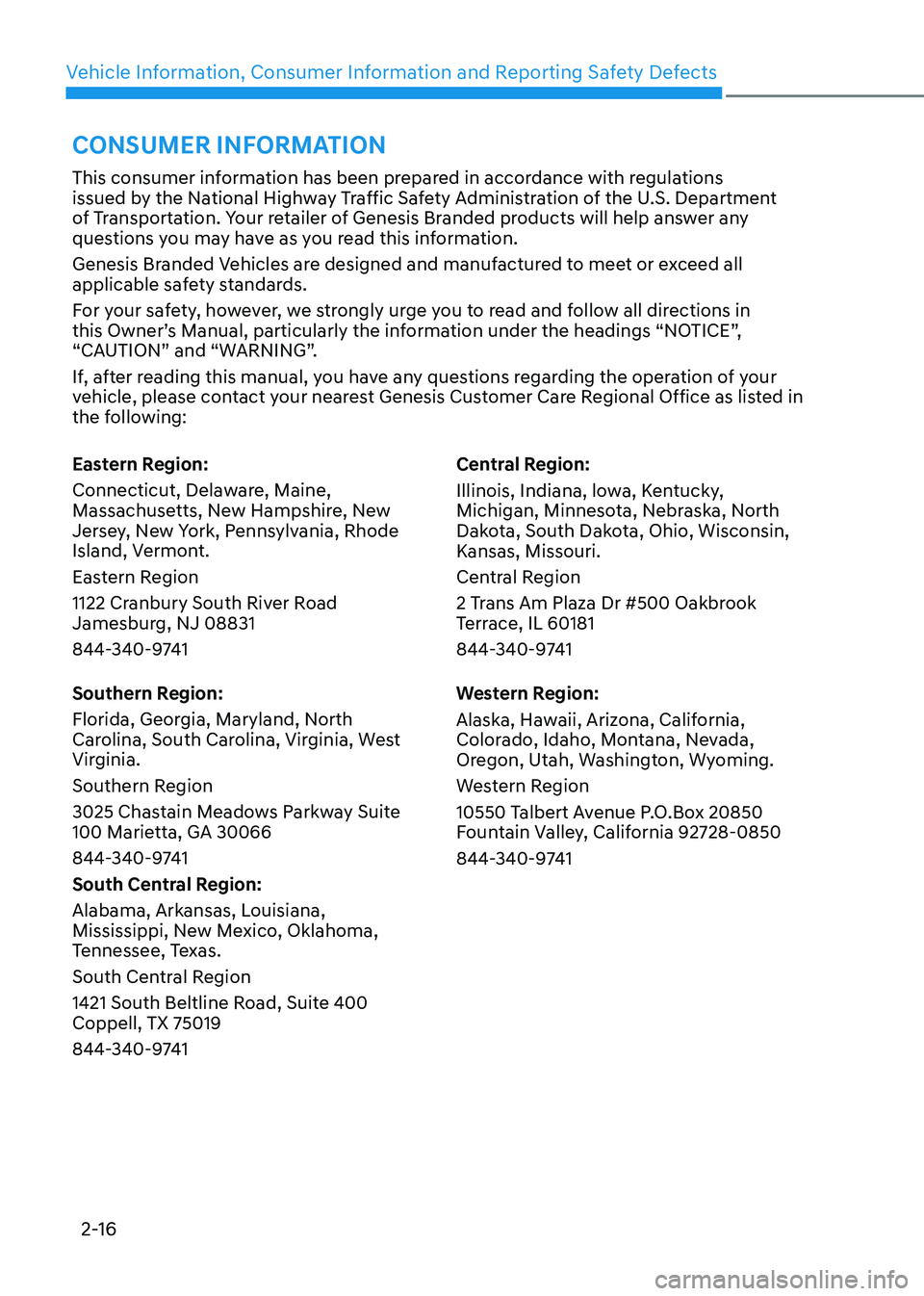
Vehicle Information, Consumer Information and Reporting Safety Defects
2-16
Eastern Region:
Connecticut, Delaware, Maine,
Massachusetts, New Hampshire, New
Jersey, New York, Pennsylvania, Rhode
Island, Vermont.
Eastern Region
1122 Cranbury South River Road
Jamesburg, NJ 08831
844-340-9741
Southern Region:
Florida, Georgia, Maryland, North
Carolina, South Carolina, Virginia, West
Virginia.
Southern Region
3025 Chastain Meadows Parkway Suite
100 Marietta, GA 30066
844-340-9741
South Central Region:
Alabama, Arkansas, Louisiana,
Mississippi, New Mexico, Oklahoma,
Tennessee, Texas.
South Central Region
1421 South Beltline Road, Suite 400
Coppell, TX 75019
844-340-9741Central Region:
Illinois, Indiana, lowa, Kentucky,
Michigan, Minnesota, Nebraska, North
Dakota, South Dakota, Ohio, Wisconsin,
Kansas, Missouri.
Central Region
2 Trans Am Plaza Dr #500 Oakbrook
Terrace, IL 60181
844-340-9741
Western Region:
Alaska, Hawaii, Arizona, California,
Colorado, Idaho, Montana, Nevada,
Oregon, Utah, Washington, Wyoming.
Western Region
10550 Talbert Avenue P.O.Box 20850
Fountain Valley, California 92728-0850
844-340-9741
CONSUMER INFORMATION
This consumer information has been prepared in accordance with regulations
issued by the National Highway Traffic Safety Administration of the U.S. Department
of Transportation. Your retailer of Genesis Branded products will help answer any
questions you may have as you read this information.
Genesis Branded Vehicles are designed and manufactured to meet or exceed all
applicable safety standards.
For your safety, however, we strongly urge you to read and follow all directions in
this Owner’s Manual, particularly the information under the headings “NOTICE”,
“CAUTION” and “WARNING”.
If, after reading this manual, you have any questions regarding the operation of your
vehicle, please contact your nearest Genesis Customer Care Regional Office as listed in
the following:
Page 29 of 632

02
2-17
If you believe that your vehicle has a defect which could cause a crash or could cause
injury or death, you should immediately inform the National Highway Traffic Safety
Administration (NHTSA) in addition to notifying Genesis Customer Care.
If NHTSA receives similar complaints, it may open an investigation, and if it finds that a
safety defect exists in a group of vehicles, it may order a recall and remedy campaign.
However, NHTSA cannot become involved in individual problems between you, your
dealer, or Genesis Customer Care.
To contact NHTSA, you may call the Vehicle Safety Hotline toll-free at 1-888-327-4236
(TTY: 1-800-424-9153);
go to http://www.safercar.gov;
download the SaferCar mobile application;
or write to: Administrator, NHTSA.
1200 New Jersey Ave, SE.,
Washington, DC. 20590.
You can also obtain other information about motor vehicle safety from
http://www.safercar.gov.
REPORTING SAFETY DEFECTS
Page 30 of 632
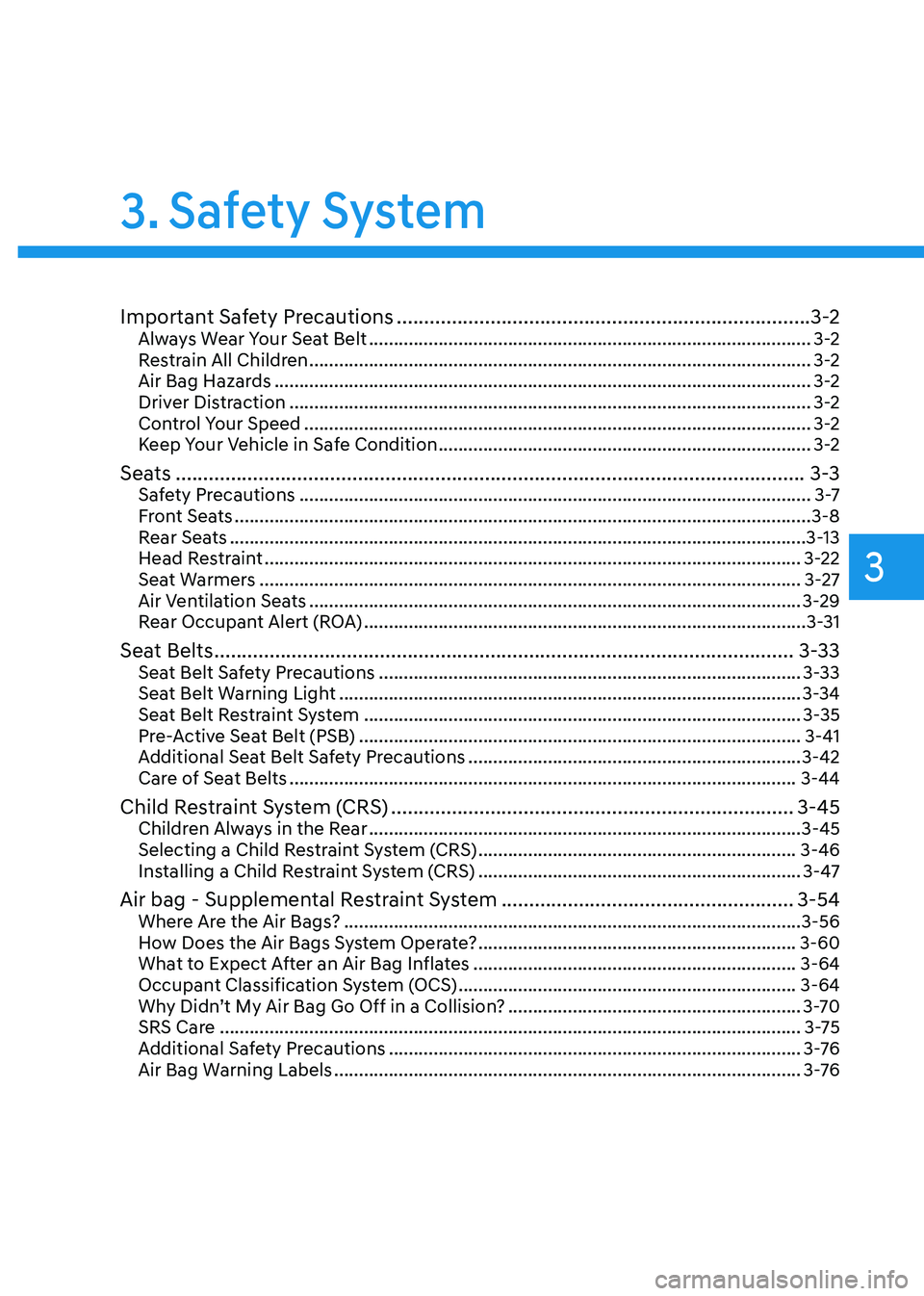
Safety System
3. Safety System
Important Safety Precautions ........................................................................\
...3-2Always Wear Your Seat Belt ........................................................................\
.................3-2
Restrain All Children ........................................................................\
.............................3-2
Air Bag Hazards ........................................................................\
....................................3-2
Driver Distraction ........................................................................\
.................................3-2
Control Your Speed ........................................................................\
..............................3-2
Keep Your Vehicle in Safe Condition ........................................................................\
...3-2
Seats ........................................................................\
..........................................3-3Safety Precautions ........................................................................\
...............................3 -7
Front Seats ........................................................................\
............................................3-8
Rear Seats ........................................................................\
............................................3-13
Head Restraint ........................................................................\
....................................3-22
Seat Warmers ........................................................................\
.....................................3-27
Air Ventilation Seats ........................................................................\
...........................3-29
Rear Occupant Alert (ROA) ........................................................................\
.................3-31
Seat Belts ........................................................................\
.................................3-33Seat Belt Safety Precautions ........................................................................\
.............3-33
Seat Belt Warning Light ........................................................................\
.....................3-34
Seat Belt Restraint System ........................................................................\
................3-35
Pre-Active Seat Belt (PSB) ........................................................................\
.................3-41
Additional Seat Belt Safety Precautions ...................................................................3-42
Care of Seat Belts ........................................................................\
..............................3-44
Child Restraint System (CRS) ........................................................................\
.3-45Children Always in the Rear ........................................................................\
...............3-45
Selecting a Child Restraint System (CRS) ................................................................3-46
Installing a Child Restraint System (CRS) .................................................................3-47
Air bag - Supplemental Restraint System .....................................................3-54Where Are the Air Bags? ........................................................................\
....................3-56
How Does the Air Bags System Operate? ................................................................3-60
What to Expect After an Air Bag Inflates .................................................................3-64
Occupant Classification System (OCS) ....................................................................3-64
Why Didn’t My Air Bag Go Off in a Collision? ...........................................................3-70
SRS Care
........................................................................\
.............................................3-75
Additional Safety Precautions ........................................................................\
...........3 -76
Air Bag Warning Labels ........................................................................\
......................3 -76
3